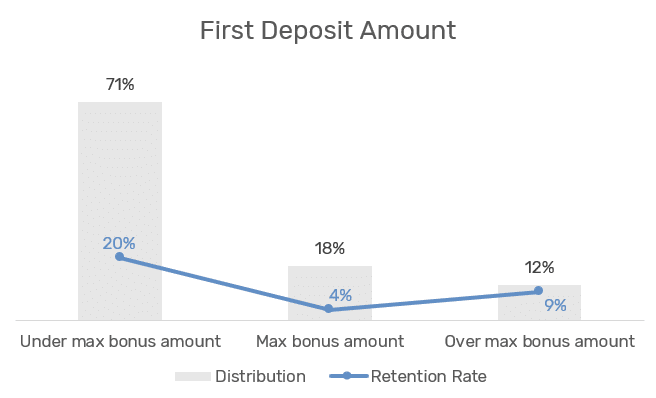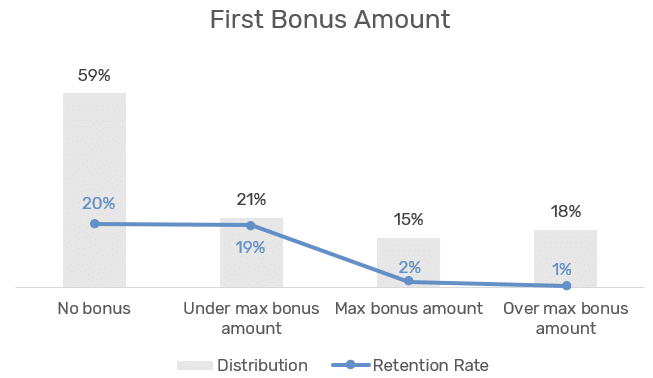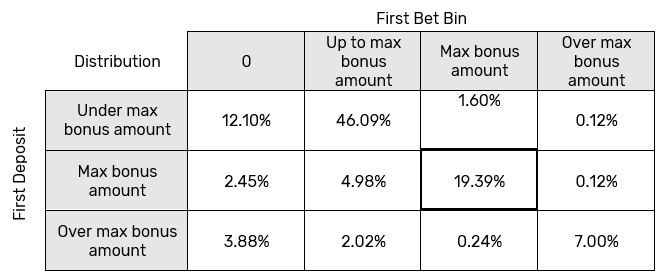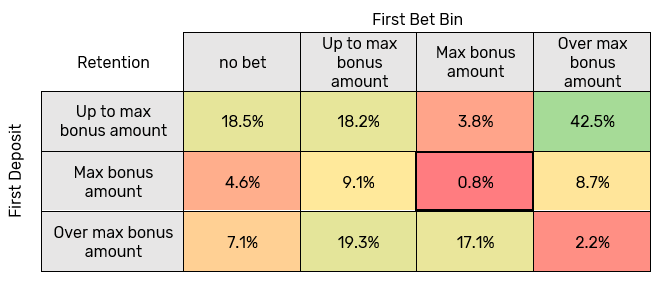
AI and the Retail Marketer’s Future
How AI transforms strategy and processes, driving the adoption of Positionless Marketing
Exclusive Forrester Report on AI in Marketing

One of the biggest attractions in online gaming is a great welcome promotion. The objective of this kind of bonus is to get players enthusiastic about the site, in the hopes of turning them into long-term players.
Bonus abusers have a significantly lower retention rate and will do the minimum needed to get the maximum from the offered bonus. For example, if the bonus suggested will match 100% up to $200, they will deposit exactly $200. In this situation, the player will likely find the games with the highest payouts and the lowest risk.
These players will usually withdraw the money and not make another deposit, at least without another big bonus. It’s important for Gaming companies to identify these players and include them in a different marketing plan, while investing the money in more loyal players.
It is up to the brand to determine whether a player is actually abusing the bonus rewards. The definition of bonus abusers may range from a bet amount that equals the bonus amount, exact deposit amount to reach the maximum bonus, minimum number of bets or games in order to qualify for withdrawing, and others.
In this blog, I focused on Sports Book bonus abusers. The analysis was conducted on players who made their first deposit as well as their subsequent behavior. I looked for the strongest categories that could predict whether a first depositor will become a bonus abuser.
I split each category into bins and looked for the bin with the lowest retention rate. I defined retention as players who made another deposit 30 days after their first deposit. The data is based on players who made their first deposits within a year. I analyzed 5 leading brands with a similar welcome offer of a match bonus—which means an online brand matches the player's first deposit by a certain percentage, up to a certain amount of money.
The first step in defining a bonus abuser is a single category analysis. The graph below show the first deposit. The lowest retention rate (4%) are players who made their first deposit with the amount that earned them the maximum bonus.

Another category is the first bet amount; here, players who placed their first bet with the maximum bonus amount had the lowest probability of depositing in the next 30 days.

Other categories I examined were: first bonus amount, first ticket type, number of bets on the deposit day, number of bets on the bonus day, second bet amount, and the odds of the first bet. The lowest retentions rates were players who made a single bet on the deposit day and a second bet amount that equaled the initial bonus.
The next step of finding the suitable definition is joining the categories mentioned above to find the combination that highlights the lowest retention rate and reduces the group size.
In this analysis, I included only customers who received a bonus on the first deposit. The lowest retention rate (0.8%) is from customers who made their first deposit with the exact amount that qualified them with the maximum bonus and their first bet, which equaled the maximum bonus received.


The last steps suggests a possible bonus abuser’s definition. On one side, we would like to have a small group size because we do not want to exclude too many players from getting promotions, but on the other side, it shouldn't be too granular that the definition loses its meaning. If needed, I can join more than two categories to reduce the number of players identified as bonus abuser (like the first deposit and bet amount with sport ticket type or ticket odds).
Some brands tried to reduce the number of bonus abusers by dividing the welcome bonus from the first two deposits; for example, up to 200 euros welcome bonus - up to 100 in the first deposit and up to 100 in the second, or 100% match on the first deposit and 50% match on the second.
As can be seen from the charts, for players who deposit under or over the maximum bonus amount, the chances of making another transaction increase as the number of the initial transactions increase. Players who deposit within the full bonus range have only a 17% chance of continuing to a 3rd deposit.

The analysis above exemplifies the general steps defining bonus abusers. After doing so, I recommend implementing these attributes and creating a “Soft Marketing Plan,” or a marketing plan based on content rather than promotions. Campaigns in this marketing plan can include newsletter, information about new games, personal games of bets suggestions base on favorite product and more. It's important for Gaming companies to identify these players and include them in a different marketing plan, while investing the money in more local players. An ideal marketing plan should include a condition that allows the player back into the regular marketing plan. Once customers who were marked as bonus abusers make a deposit without a bonus, their bonus abuser flag will be removed and they will no longer be counted as bonus abusers. Use your bonus abuser definition to flag those who won't return and set aside those bonuses or promotions for only the most loyal customers.
Exclusive Forrester Report on AI in Marketing
In this proprietary Forrester report, learn how global marketers use AI and Positionless Marketing to streamline workflows and increase relevance.


Writers in the Optimove Team include marketing, R&D, product, data science, customer success, and technology experts who were instrumental in the creation of Positionless Marketing, a movement enabling marketers to do anything, and be everything.
Optimove’s leaders’ diverse expertise and real-world experience provide expert commentary and insight into proven and leading-edge marketing practices and trends.


